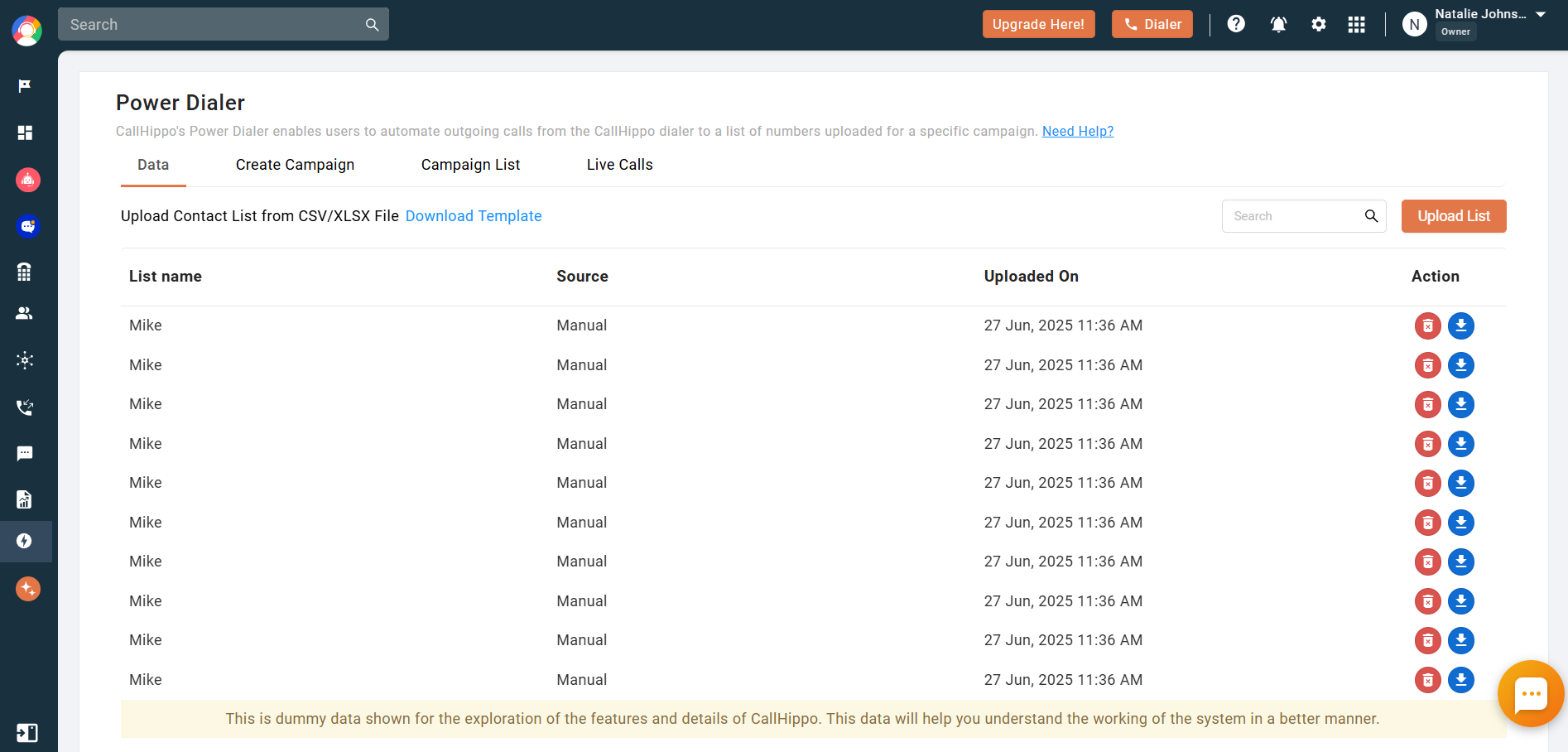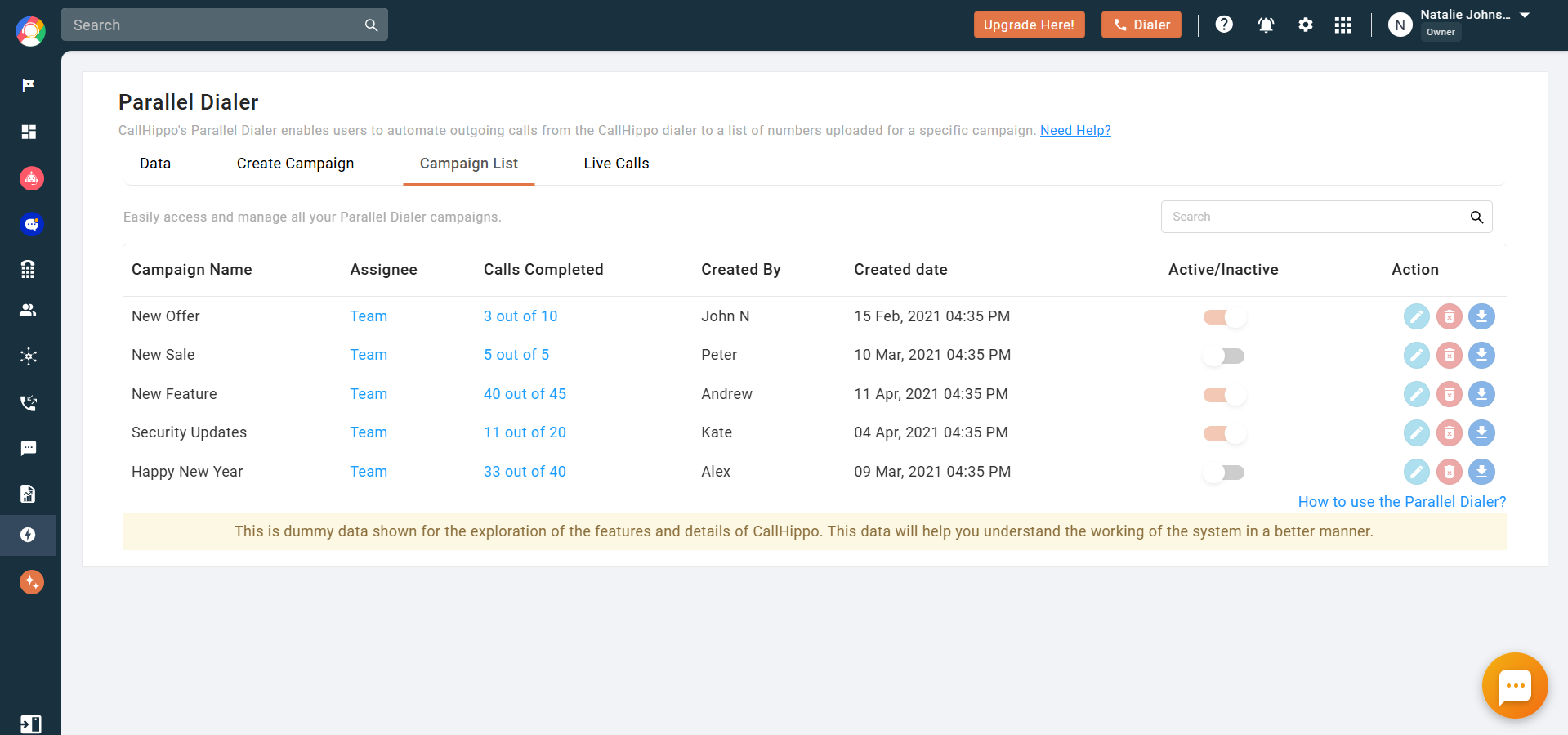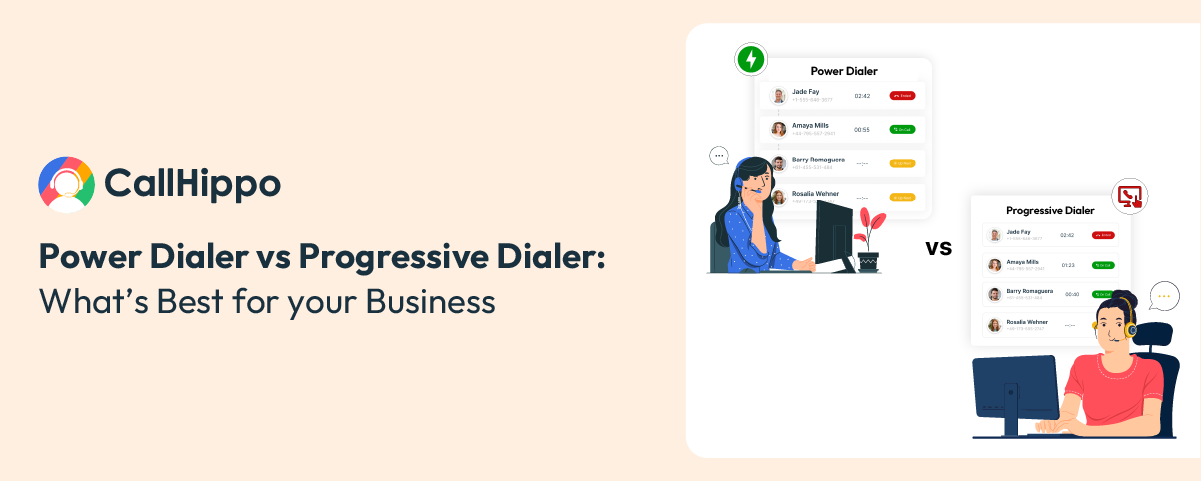Know About Power Dialer vs Progressive Dialer in 30 Seconds
A power dialer automatically calls the next number right after the previous call ends, connecting the agent as soon as a live person answers. In contrast, a progressive dialer also dials numbers one by one but allows agents to review some details about the upcoming call before it connects.
| Dialing Speed | Calls are placed immediately after the prior call finishes, maximizing speed. | Agents can take a moment to prepare before the next call, which may slow the pace. |
| Call Information | Focuses on rapid dialing without providing much pre-call data to agents. | Gives agents relevant info ahead of time for a tailored approach. |
| Agent Productivity | Generates a high volume of calls but may limit agent prep time. | Supports better preparation, potentially leading to more meaningful conversations. |
| Best Use Case | Ideal for campaigns that prioritize volume and quick outreach. | Suited for roles requiring personalized interaction, like sales or support. |
- CallHippo Solutions:
- Power Dialer for fast-paced, high-volume calling.
- Progressive Dialer for controlled, compliance-friendly outreach.
- Predictive Dialer for AI-driven efficiency in large teams.
- Parallel Dialer for multi-line simultaneous dialing to boost connection rates.
Nowadays, one of the smartest ways to close more deals is by streamlining outbound calling with advanced sales dialers.
In fact, Power Dialers – One of the well-known sales dialers – can automate outbound calls and increase team efficiency by up to 70%. They help your reps connect with more qualified leads each day while cutting wasted time.
But here’s the catch: not every dialer is built for the same job.
To truly align your sales tech with your revenue goals, you need to understand the difference between different dialers. This guide breaks it down and helps you pick the right one.
What is a Power Dialer?
Power dialer can be defined as a type of automated dialing system that calls numbers from a list one by one when an agent is ready to dial. It only proceeds to the next call after the previous call ends or is unanswered.
Key Features:
- Dials one call per available agent
- Skips busy tones, unanswered calls, and disconnected lines
- Connects automatically to agents without delay
- Drops a pre-recorded message if the call is missed
- Integrated call recording and CRM integration
A sales rep using a power dialer can easily triple their number of calls per hour. This feature makes it ideal for high-volume outreach in call centers and cold calling.
What Is a Progressive Dialer?
A progressive dialer works similarly but gives more control to agents. It dials the next number only after the agent completes their previous call and signals readiness.
Key Features:
- Waits for agent availability prior to starting a call
- Suitable for industries with compliance regulations
- Enhances customer satisfaction by reducing call abandonment rates
- Supports personalized calls with access to contact details pre-dial
Progressive dialers prioritize quality and compliance over speed, which makes them perfect for industries like finance, healthcare, and B2B sales.
Power Dialer vs Progressive Dialer: Key Differences
When it comes to outbound campaigns, the way you manage your call flow directly shapes your pipeline velocity and close rates. Not all dialers are built the same! So, understanding the operational differences between a power dialer and a progressive dialer can make a huge difference. Let’s break down their core differences so you can align the right tool with your team’s workflow, priorities, and revenue targets.
| Feature | Power Dialer | Progressive Dialer |
|---|---|---|
| Dialing Speed | Moderate — dials the next number only after the agent manually wraps the prior call. | |
| Agent Control | Higher — agents control call pacing and initiate each call when ready. | |
| Agent Efficiency | Moderate — ensures quality pacing but at a slower volume | |
| Call Connection Logic | Waits for the agent to wrap up his current call before dialing the next number. | |
| Best Fit For | Relationship-based, compliance-heavy industries like finance, healthcare, or enterprise accounts | |
| Compliance Risk | Low — one-to-one dialing ensures every connected call is handled live | |
| Ideal Sales Use Case | Client retention, financial consultations, enterprise sales outreach. |
Power Dialer vs Auto Dialer vs Predictive Dialer
Choosing the right dialing technology is crucial to optimizing your sales team’s efficiency and compliance. Each dialer type serves a distinct purpose, catering to different sales strategies and customer engagement needs. Understanding their core differences will help you align your outreach approach with your business goals.
Definitions and Use Case
| Feature | Power Dialer | Progressive Dialer |
|---|---|---|
| Auto Dialer | Small-scale or informal outreach. | |
| Power Dialer | Speed-focused sales teams | |
| Progressive Dialer | Regulated or relationship-based sales | |
| Predictive Dialer | Large-scale call centers and high-volume operations |
Power Dialer vs Auto Dialer
Power dialers and auto dialers both simplify outbound calling, but they’re built for different moments in your sales strategy.
An auto dialing is clean and uncomplicated — it moves through a call list sequentially. This dialing is a smart pick for small teams or early-stage outreach when the goal is volume over nuance.
A power dialer takes that core functionality and adds intelligence. This dialer skips unanswered calls and busy signals, only connecting when an agent is available. It leads to less idle time, more live conversations, and a tighter workflow.
Here, the secret is alignment: Choose the dialer that matches your team size, outreach goals, and the complexity of your customer interactions.
Predictive Dialer vs Progressive Dialer
The choice between predictive and progressive dialing is a classic trade-off: volume versus quality.
Predictive dialers lean heavily into volume, using AI to forecast agent availability and dial multiple numbers simultaneously. This keeps agents on the line nearly 100% of the time, which maximizes talk time. But there’s a catch — higher call abandonment rates. Prospects may answer only to find no agent waiting, leading to frustration and potential brand damage.
Progressive dialers operate with the intention of dialing one number at a time only when an agent signals they’re ready. This measured pace offers elevated control, drastically reducing abandoned calls — a critical advantage in industries like healthcare and finance where compliance and customer trust aren’t negotiable.
Power Dialer vs Predictive Dialer
Your team size and sales goals usually dictate this choice.
Predictive dialers are built for scale. They excel in high-volume call centers with 15+ agents, where speed and efficiency drive revenue outcomes. Perfect for outreach-heavy campaigns like debt collection, telemarketing, or political canvassing, these dialers use AI to forecast agent availability and dial multiple numbers simultaneously. To make the right decision, it’s important to understand the core differences between the Power Dialer and Predictive Dialer.
For smaller teams, around 5–10 agents, power dialers offer a compelling middle ground. They ramp up dialing speed and efficiency while maintaining call quality and agent control. This balance minimizes call abandonment and keeps conversations meaningful.
For example, a mid-sized tech sales team can use a power dialer to accelerate cold outreach without the downsides of predictive dialing’s higher abandonment rates.
If your need is call volume for political campaigns or debt collections, predictive dialing’s aggressive pace will deliver unmatched ROI, even if some calls get dropped. But when your priority is quality, compliance, and personalized conversations, a power or progressive dialer will protect your brand and foster real customer connections.
Using a progressive dialer in highly regulated industries like healthcare and finance will safeguard your business against penalties. It will ensure that a human agent is always there to adhere FCC’s call abandonment guidelines and other government restrictions.
How to Choose the Right Dialer for Your Sales Team?
Selecting the right dialing system isn’t about grabbing the best-in-class features! However, it’s more about aligning technology with your team’s structure and customer expectations. Below are important factors to guide your decision.
1. Call Volume
Start by quantifying your average daily outbound calls. If your team makes hundreds of calls a day, you’ll need a dialer designed for speed and scalability, like a power dialer or predictive dialer. Conversely, lower-volume, relationship-driven teams might benefit from the measured pace of a progressive dialer.
2. Team Size
Size matters here. Predictive dialers work well in environments with 15+ agents, while power dialers offer an ideal fit for mid-sized teams. Additionally, smaller teams often opt for progressive dialers due to their deliberate and compliance-safe approach.
3. Compliance
In industries like healthcare, finance, or insurance, where strict dialing regulations exist, a progressive dialer can help safeguard against regulatory risks by ensuring agents are always present when a call connects.
CallHippo’s Dialer Solutions
Outbound calling isn’t one-size-fits-all. Different campaigns demand different dialing strategies, and CallHippo gets that. Whether you need to move fast or strike the perfect balance between speed and personalization, there’s a dialer built for your workflow. Here’s a quick breakdown of what CallHippo offers:
1. Power Dialer
 This power dialer software helps outbound teams move faster by automating the dialing process. It cuts downtime between calls as agents don’t have to waste time behind manual dialing and spend more time actually talking to customers.
This power dialer software helps outbound teams move faster by automating the dialing process. It cuts downtime between calls as agents don’t have to waste time behind manual dialing and spend more time actually talking to customers.
2. Progressive Dialer
For teams that need a steady, controlled pace, the Progressive Dialer lets agents finish a call and review details before the next one dials. It’s seamless, organized, and built to keep conversations intentional.
3. Predictive Dialer
The Predictive Dialer takes efficiency up a notch by forecasting agent availability and dialing multiple numbers at once. It keeps your team’s talk time high and idle time low — perfect for fast-moving, high-volume environments.
4. Parallel Dialer
 Designed for teams chasing speed and reach, CallHippo’s Parallel Dialer can dial multiple calls simultaneously, connecting agents to whoever picks up first. It’s a smart way to boost live conversations without sacrificing control.
Designed for teams chasing speed and reach, CallHippo’s Parallel Dialer can dial multiple calls simultaneously, connecting agents to whoever picks up first. It’s a smart way to boost live conversations without sacrificing control.
| CallHippo Dialer Benefits | Power Dialer | Progressive Dialer | Predictive Dialer | Parallel Dialer |
|---|---|---|---|---|
Summing Up
The right dialer isn’t just about call volume — it sets the tone for your outreach, protects customer experience, and keeps your brand sharp. Whether you need speed or precision, CallHippo’s dialer suite makes it easy to match the right tool to every campaign. Try it today and see the difference for yourself.
FAQs
1. What is the difference between a power dialer and a progressive dialer?
A power dialer automatically dials the next call as soon as an agent is free, boosting volume. A progressive dialer waits for agents to finish before dialing, focusing on control and compliance.
2. Are power dialers and auto dialers the same?
No, auto dialers call international as well as local numbers sequentially without skipping busy signals, while power dialers skip unanswered calls and connect only when agents are ready.
3. Which is better: predictive dialer or progressive dialer?
Predictive dialers maximize call volume using AI but risk more dropped calls; progressive dialers offer one call at a time for a better customer experience and compliance.
4. What types of businesses benefit most from power dialers?
Power dialers are ideal for high-volume sales teams like telemarketers, appointment setters, and mid-sized tech sales looking to save time, along with quality control.

Subscribe to our newsletter & never miss our latest news and promotions.








